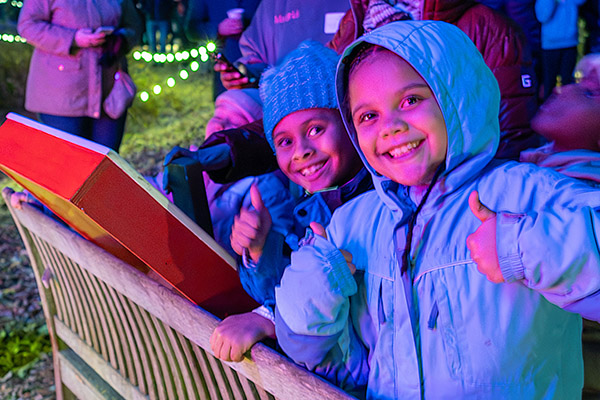The holidays are a dazzling time of excess and ornament, the ultimate celebration. But is it possible to go all out with the decorations without being wasteful? Since the Garden’s undergoes a festive transformation each year for WPS Garden of Lights, we know a thing or two about sustainable holiday decorations.
So, whether it’s indoors or outdoors, we have plenty of tips to share with you!
Shop Secondhand
Getting something new is fun and exciting. By purchasing holiday decorations second hand, they’re still new to you without the waste of being fresh off the mass market. Plus, a visit to the thrift store can be a great way to cut costs! There are plenty of pre-owned holiday decorations towards the end of fall at a fraction of the price you’d pay for them in a retail store.

This comes with the stipulation of using caution when purchasing second-hand items with an electronic or lit element. Stick to the past couple of decades if you aren’t ready to rewire a light or deal with overheating elements.
Looking for something extra special? Take a trip to your local antique store. While vintage decorations may come with a higher price tag, their age often comes with higher quality construction and unique aesthetics. So, treat yourself to some midcentury glass ornaments, an antique candle holder, or whatever your heart desires.
After all, half of the new stuff is trying to manufacture the retro vibes of yesteryear.
The Holiday Tree Debacle4
One of the biggest holiday decorations is likely your tree. The age-old debate is whether you should opt for a real or artificial tree. Like many things in life, it depends! If you’ve opted for an artificial tree, it’s important that you keep it for as many years as possible before you upgrade. Because the upfront use of raw materials and energy from manufacturing is so high in artificial trees, you have to keep it for multiple years for it to even come close to being as ecofriendly as a natural tree. If you can, donate your artificial tree when you’re done with it. This gives it a chance at a second life.

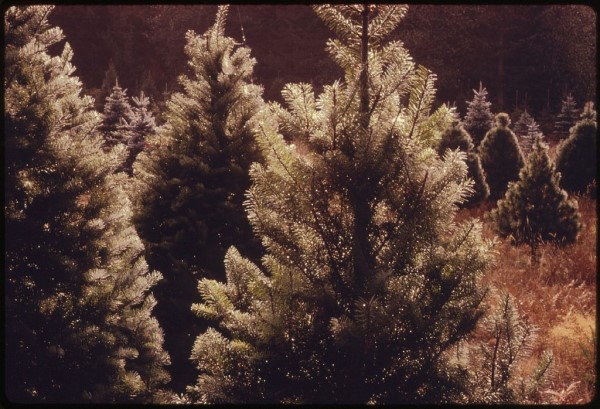
There are also things to consider if you’re hunting for the perfect natural tree. Firstly, is your transportation. Transportation has a big impact on the environmental impact of your holiday tree. Try to choose a tree vendor close to home or carpool with friends and family to minimize the carbon footprint of your travel. Also, try not to let your natural tree end up in the landfill. Landfills aren’t optimal environments for the breakdown of organic materials, so your tree is much better off as mulch, in compost, or at a yard waste disposal site.
That all being said, don’t let your conscious keep you from enjoying a decorative tree during the holiday season. Rest assured knowing that your tree, whether artificial or natural, is less than 0.1% of your carbon footprint each year. Take the bus sometimes, have a vegetarian night once a week, or take shorter showers because, ultimately, it’ll do a lot more good than going cold turkey on holiday trees.
Hold a Crafting Party
A lot of the most sustainable tree ornaments are the ones that you can make yourself. It’s a great opportunity to have a few friends over, put some festive movies on, and make a day of creating handcrafted decorations. If you aren’t the most artistically inclined, dried fruit ornaments and garlands can be a fantastic starting point. If you’re confident in your DIY abilities, you could make stars from recycled paper or even design and paint your own salt dough ornaments.

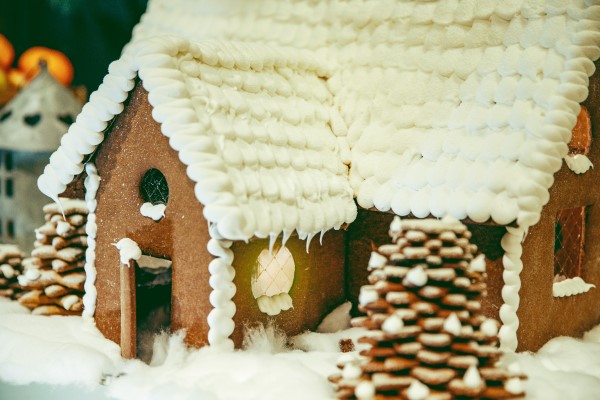
Another engaging group activity is gingerbread houses. While you could purchase them pre-made, baking them from scratch allows you to be as elaborate as you’d like. With plenty of shapes to build and ways to decorate, each house reflects the maker’s personality. If a gingerbread house caves in or turns out poorly, don’t worry; that’s half the fun anyway!
Modernize Your Lights
Since we use over 350,000 lights at WPS Garden of Lights, we know a thing or two about how to be kinder to the environment while still enjoying the glow of holiday decorations. Trading your traditional string lights for efficient LED lights is an easy swap that has a big impact.
LED lights last much longer than incandescent lights, making them a better investment. They also use a staggering 90% less energy than traditional lights. Here at the Garden, we keep our use of incandescent lights to a minimum, using less than 1,000 each season. If you miss the warmer glow of incandescent string lights, look for vintage-style LED lights with classic colors. They have all the nostalgia while draining a fraction of the energy that vintage lights would.

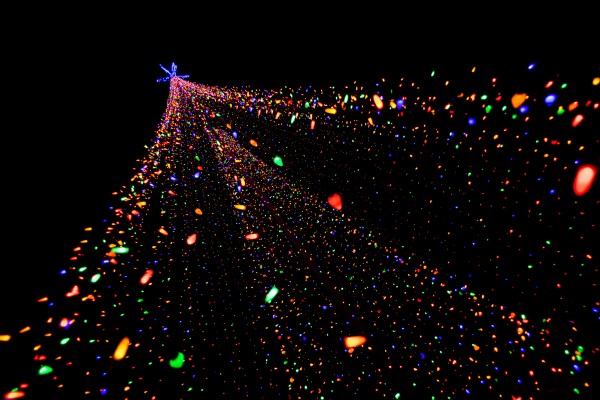
It’s also common practice to put your decorative lights on a timer. This helps save additional energy when no one is awake to appreciate your beautiful house. In fact, it allows those who need a little shut eye, our local wildlife, to have a more restful evening. If you really want to go the extra mile, you could also opt for lights that are solar powered which don’t use any municipal energy. These often aren’t as bright, but it can be a great option for smaller accents like path lighting candy canes or a whimsical lantern.
Once your string lights have stopped working, it’s also important that you properly dispose of them. First, check and make sure that none of the lights need to be replaced or tightened. If it truly is the end of the road, recycle your lights at your local electronic recycling center. If you don’t, they’ll unfortunately end up in the landfill.
Use What You Have
One of the most sustainable and cost-effective ways to decorate for the holidays is to reuse decorations that you already have. Whether you’re swapping décor with friends and family or digging things out of the basement, not purchasing new items helps to reduce material consumption and production emissions.
Feeling a little bored with what you have? Maybe there are ways that you can freshen up items that you’ve had for years. Small adjustments like a new coat of paint can do wonders.
Shop in Your Own Backyard
If you really want to save a buck, you can’t find a better deal than foraging in your own backyard for holiday décor! Simple items like pinecones, evergreens, twigs, and dried flowers from last season can make stunning wreaths and swags. In fact, if you need inspiration, come visit the Garden and check out our Natural Holiday Trees. They’re a prime example of how stunning foraged decorations can be.

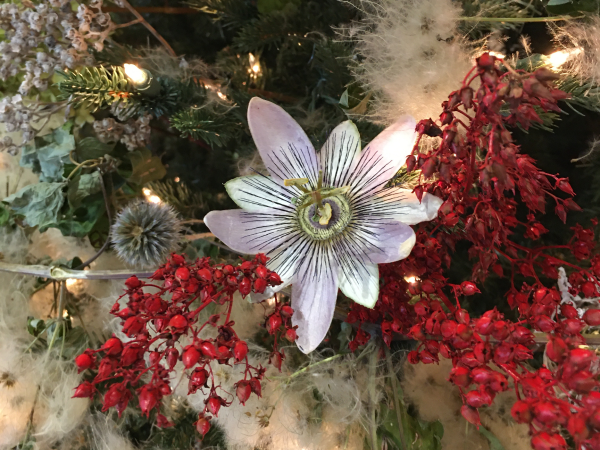
If you need a helping hand, check out our fool-proof formula for dried flower ornaments:
- Each season, we select annual flowers to grow based on their ability to retain color and shape when they’ve been dried. This takes some planning ahead, but it makes the ornaments fuller and much more vibrant.
- In summer, when the flowers are in bloom, we collect the flowers and start to dry them. There isn’t an exact number that we need, so we tend to eyeball it. You can always make the ornaments smaller if flowers are scarce, so just go with your gut.
- Some flowers, like statice, lavender, yarrow, strawflower, allium, globe amaranth, and hydrangea do best when they’re air dried. We tie them into bundles and hang them to dry in a dark place.
- Some flowers hold up better if a drying agent, like silica sand, is applied. Hydrangeas, roses, black-eyed Susans, zinnias, dahlias, and Queen Anne’s lace are dried for about a week or so in the sand.
- Now that your flowers are dried, its time to assemble! We arrange them into small bouquets and spheres. Still, every dried flower decoration turns out a little differently. If your struggling to shape your ornament, don’t worry. You really can’t go wrong when you’re starting with gorgeous dried flowers
- Now you can hang them up! They’ll look stunning on your tree all season long. If you have a few favorites, be sure to package them up and keep them in a cool dry place so you can enjoy them for another year!
Sources
1. “18 Ways to Have a Green Eco-Friendly Christmas.” Country Living, Hearst UK, 2 Nov. 2021, www.countryliving.com/uk/homes-interiors/interiors/g25329535/eco-friendly-christmas-ideas-green-christmas/.
2. Kellogg, Kathryn. “The Ultimate Guide to a Zero Waste and Sustainable Christmas.” Going Zero Waste, 11 Dec. 2018, www.goingzerowaste.com/blog/how-to-have-an-eco-friendly-and-zero-waste-christmas/.
3. “Sustainable Holidays: Eco-Friendly Decoration, Shopping & Giving Ideas.” Grove Collaborative, 9 Nov. 2021, www.grove.co/blog/sustainable-holiday-celebrations#7oBGiTu1Vcm0JKI7fjF2pT.
4. Americas, P. E. “Comparative life cycle assessment of an artificial Christmas tree and a natural Christmas tree.” Boston, MA: Final Report for the American Christmas Tree Association (2010).






